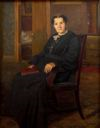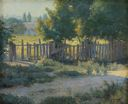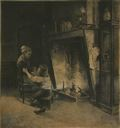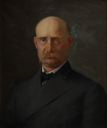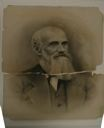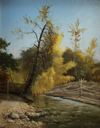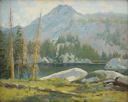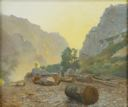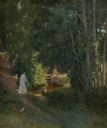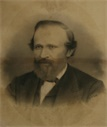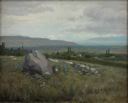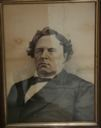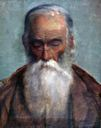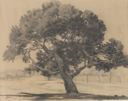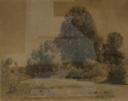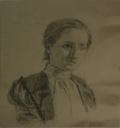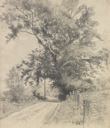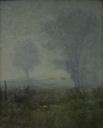John Hafen
paintings, landscape painting
(Scherzingen, Switzerland, 1856 - 1910, Brown County, Indiana)
John Hafen was born in 1856 in Scherzingen, Switzerland. His family, converts to the LDS faith, came to the United States when Hafen was six years old, determined to join the "Saints" in Utah. On the way, they spent 12 days in Winter Quarters, Nebraska, and Hafen's two-year-old brother died there. They made the rest of the journey by ox team. After reaching Utah, the Hafens settled first in Payson and then after two other moves, established themselves in Salt Lake City in 1868. John was very interested in art from a young age and became one of the youngest and earliest students at the "Twentieth Ward Academy" or "Seminary," in Salt Lake City, a school that included drawing instruction in its lessons. During the next ten years, Hafen was taught by George Ottinger and Dan Weggeland, two early Utah artists who not only became friends with the young Hafen, but also encouraged him to seek traditional training outside Utah. In 1881, a group of young artists, including Hafen, founded the Utah Art Association, which later became the Utah Art Institute. The Association's purpose was to produce exhibitions and provide art instruction. The initial exhibit was the first time artists in Utah had organized and directed their own show. Over the next nine years, John continued to paint and draw and exhibit when possible, including at George A. Meears' sample room, he was a whisky wholesaler, where space was available for local artists to display their work, free of charge. In 1890, Hafen helped convince LDS church authorities to sponsor the "French Art Mission," an opportunity to study at the Acadamie Julian in Paris. The trip also was made possible for several other young Utah artists, J. B. Fairbanks, Lorus Pratt, and Edwin Evans. The artists' studies in France were subsidized by the LDS church so the artists could improve their skills and paint murals and paintings in the LDS temples upon their return to Utah. Hafen's studies in Paris had a vital impact on his work; like many other young artists of the time, he switched his interest from academic studio work to landscape painting from nature. Espousing his new view, Hafen wrote, "Cease to look for mechanical effect or minute finish, for individual leaves, blades of grass, or aped imitation of things, but look for smell, for soul, for feeling, for the beautiful in line and color." Back in Utah by 1892, Hafen began work on the murals for the Salt Lake temple. Although Hafen did the most work, Pratt, Fairbanks, Evans, and Dan Weggeland all contributed their Paris-honed skills. The next year, the Society of Utah Artists was reestablished with Hafen serving as Vice President. The society's exhibits were well received, with many people willing to pay the entrance fees. Although Hafen's paintings from the middle 1890s to about 1907 are now considered "masterpieces of Utah art," he wasn't able to support his fast-growing family on what he made from his work. Consequently, he held various jobs and at times received support from the Church in exchange for paintings and drawings, which now make up the impressive Hafen collection at the Museum of Church History and Art in Salt Lake City. Hafen taught at the Brigham Young Academy and eventually settled in Springville with his wife and ten children. Originally the family lived with the Myron Crandall Jr. family because the Hafens couldn't afford to pay rent. Later, Hafen traded a painting for a hilly section of Crandall's land. Alberto O. Treganza, a close friend of the Hafens, designed their home in the Swiss chalet style. The building was paid for by sales of paintings and the bartering of paintings to a local doctor who traded the paintings for work his destitute patients did on the Hafen home. To cover one bare cement wall, Hafen painted a mural of hollyhocks and attached it to the wall. After Hafen's death, the canvas was removed, mounted and framed and is now owned by the Springville Museum of Art. The Hafen home in Springville still stands today. While in Springville, his interest in art education led Hafen to donate a painting to the Springville High School and to encourage other artists (including his friend Cyrus Dallin) to donate artwork. This art collection grew and eventually necessitated a building to house and display the art: it became the Springville Museum of Art. Although Hafen made frequent painting and selling trips across the country, he lived in extreme poverty until he moved to Indiana late in his life. There, he was accepted into a group of regional impressionist artists and at last began to achieve success as an artist, including winning a prestigious commission to paint the governor's portrait. He lived in an attractive cottage overlooking a beautiful valley, surrounded by friends. However, just as he began to realize his life-long dream of providing for his family through sales of his art, Hafen contracted pneumonia and died in 1910. Ironically, John Hafen is now considered the most appealing of the early Utah stylists, and was called "Utah's greatest artist" by Alice Merrill Horne, an early Utah art activist. He, of all the early Utah artists, best communicated the poetic essence of nature.
paintings, landscape painting
(Scherzingen, Switzerland, 1856 - 1910, Brown County, Indiana)
John Hafen was born in 1856 in Scherzingen, Switzerland. His family, converts to the LDS faith, came to the United States when Hafen was six years old, determined to join the "Saints" in Utah. On the way, they spent 12 days in Winter Quarters, Nebraska, and Hafen's two-year-old brother died there. They made the rest of the journey by ox team. After reaching Utah, the Hafens settled first in Payson and then after two other moves, established themselves in Salt Lake City in 1868. John was very interested in art from a young age and became one of the youngest and earliest students at the "Twentieth Ward Academy" or "Seminary," in Salt Lake City, a school that included drawing instruction in its lessons. During the next ten years, Hafen was taught by George Ottinger and Dan Weggeland, two early Utah artists who not only became friends with the young Hafen, but also encouraged him to seek traditional training outside Utah. In 1881, a group of young artists, including Hafen, founded the Utah Art Association, which later became the Utah Art Institute. The Association's purpose was to produce exhibitions and provide art instruction. The initial exhibit was the first time artists in Utah had organized and directed their own show. Over the next nine years, John continued to paint and draw and exhibit when possible, including at George A. Meears' sample room, he was a whisky wholesaler, where space was available for local artists to display their work, free of charge. In 1890, Hafen helped convince LDS church authorities to sponsor the "French Art Mission," an opportunity to study at the Acadamie Julian in Paris. The trip also was made possible for several other young Utah artists, J. B. Fairbanks, Lorus Pratt, and Edwin Evans. The artists' studies in France were subsidized by the LDS church so the artists could improve their skills and paint murals and paintings in the LDS temples upon their return to Utah. Hafen's studies in Paris had a vital impact on his work; like many other young artists of the time, he switched his interest from academic studio work to landscape painting from nature. Espousing his new view, Hafen wrote, "Cease to look for mechanical effect or minute finish, for individual leaves, blades of grass, or aped imitation of things, but look for smell, for soul, for feeling, for the beautiful in line and color." Back in Utah by 1892, Hafen began work on the murals for the Salt Lake temple. Although Hafen did the most work, Pratt, Fairbanks, Evans, and Dan Weggeland all contributed their Paris-honed skills. The next year, the Society of Utah Artists was reestablished with Hafen serving as Vice President. The society's exhibits were well received, with many people willing to pay the entrance fees. Although Hafen's paintings from the middle 1890s to about 1907 are now considered "masterpieces of Utah art," he wasn't able to support his fast-growing family on what he made from his work. Consequently, he held various jobs and at times received support from the Church in exchange for paintings and drawings, which now make up the impressive Hafen collection at the Museum of Church History and Art in Salt Lake City. Hafen taught at the Brigham Young Academy and eventually settled in Springville with his wife and ten children. Originally the family lived with the Myron Crandall Jr. family because the Hafens couldn't afford to pay rent. Later, Hafen traded a painting for a hilly section of Crandall's land. Alberto O. Treganza, a close friend of the Hafens, designed their home in the Swiss chalet style. The building was paid for by sales of paintings and the bartering of paintings to a local doctor who traded the paintings for work his destitute patients did on the Hafen home. To cover one bare cement wall, Hafen painted a mural of hollyhocks and attached it to the wall. After Hafen's death, the canvas was removed, mounted and framed and is now owned by the Springville Museum of Art. The Hafen home in Springville still stands today. While in Springville, his interest in art education led Hafen to donate a painting to the Springville High School and to encourage other artists (including his friend Cyrus Dallin) to donate artwork. This art collection grew and eventually necessitated a building to house and display the art: it became the Springville Museum of Art. Although Hafen made frequent painting and selling trips across the country, he lived in extreme poverty until he moved to Indiana late in his life. There, he was accepted into a group of regional impressionist artists and at last began to achieve success as an artist, including winning a prestigious commission to paint the governor's portrait. He lived in an attractive cottage overlooking a beautiful valley, surrounded by friends. However, just as he began to realize his life-long dream of providing for his family through sales of his art, Hafen contracted pneumonia and died in 1910. Ironically, John Hafen is now considered the most appealing of the early Utah stylists, and was called "Utah's greatest artist" by Alice Merrill Horne, an early Utah art activist. He, of all the early Utah artists, best communicated the poetic essence of nature.
Artist Objects
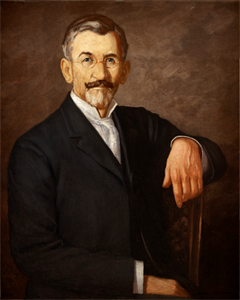
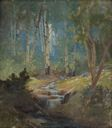

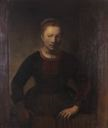



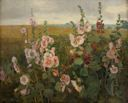








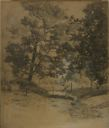



![Image of Alfalfa [Field] in November, Springville aka "Pasture"](/media/Thumbnails/1925.001_1929.999/1925.029.png)

